
25 minute read
New complications in construction’s confined space environs
Richard Millar, Chief Executive Officer, Working at Height Association
The construction industry is one that has been able to continue to operate during the coronavirus pandemic, employing many thousands of workers. However, while work continues in this industry, the day-to-day needs for protection must continue too, and the risks posed from the virus itself should also be considered — to ensure workers are appropriately protected, especially when engaged in confined space environments.
Safe Work Australia provides significant guidance for construction companies on its website regarding the duties of employers to provide adequate protections for workers — as well as additional procedures for reducing exposure and the risk of spreading the disease. Working in the construction industry can never be considered risk-free and the coronavirus (COVID-19) pandemic just adds further complications to the work environment, especially in areas which are deemed to be confined spaces, of which there are many variations.
©stock.adobe.com/au/andrej pol

In construction Confined space variations in the construction industry include: • Sewers and pits • Crawl spaces and false ceilings • Boilers and storage tanks • Ventilation shafts • Access tunnels • Telecommunications vaults • Elevator shafts
Many of these spaces are not a safe, clean environment by their very design and are often not able to be cleaned thoroughly to attain a safe work environment. Each of these areas provides challenges to the worker to remain safe, requiring through education and training a way to control the many and varied potential risks.
Generally, when working in environments deemed to be confined space, the risks to the worker can often be categorised as follows: • Low risk — When requiring access not requiring the use of escape breathing apparatus, either because the risk of a hazardous atmosphere is very low or not considered to be a hazard or that the space atmosphere is well ventilated. • Medium risk — When requiring access, the use of escape breathing apparatus, either because the risk of a hazardous atmosphere is significant or the time taken to evacuate increases risk to entrants, eg, distance travelled or where there is more than one entrant. There is a realistic expectation of encountering a specified risk either due to the intrinsic hazards or introduced/ task hazards. • High risk — When requiring access generally requires full working breathing apparatus. This is either because there is a known hazardous atmosphere or the risks of a hazardous atmosphere occurring are significant, may be due to intrinsic hazards within the space or introduced/task hazards.
Many workplace confined spaces have poor ventilation that can allow a hazardous atmosphere to quickly develop. The hazards are not always obvious, may change from one entry into the confined space to the next and depend on the workplace or environmental circumstances. There are minimum training and qualifications to be completed for those expected to work in these environments to be able to provide information, instruction and supervision.
Viral considerations Until this year, industry has not seriously considered the prospect of viruses being passed onto construction workers through close proximity in the workplace or where a person infected with COVID-19 could inadvertently pass on an airborne transmission of the virus. The virus can be easily spread by an infected person either coughing or sneezing, thereby producing an atomised virus fluid that can either cover a work surface or be inhaled by another worker.
The COVID-19 virus can be introduced to a person in a confined space or passed on to a person with standby duties if the space is: ventilated, has forced air ventilation, or where a person in the confined space is wearing breathing apparatus having an air feed from outside the space they are working in. As a worker in the confined space can be receiving air through forced ventilation, understanding the risk will go a long way to helping protect the worker. Contamination of the work surfaces after exiting the space, or in the air coming from the confined space, which may travel beyond the 1.5 metres, are also risks.
Confined space training is designed to help workers understand the risks. It covers: • how to properly wash hands; • how to fit and use any necessary personal protective equipment (PPE); • adequate cleaning practices required throughout the day; • how to set up a safe workplace; and • instructions associated with staying home from work if sick.
Training providers are required to maintain a safe training environment. This includes: • cleaning the workplace regularly and thoroughly; • restructuring the layout of the workplace to allow for physical distancing; • limiting the number of people in the training area at any given time; • requesting that trainees wear face masks.
Training providers should have adequate facilities in the workplace to protect workers from contracting COVID-19. This includes: • a washroom and facilities to include an adequate supply of soap, water and paper towel (workers should be provided with regular breaks to use these facilities, particularly to wash their hands) — if it is not possible for workers to wash their hands, an adequate supply of hand sanitiser needs to be made available; and • workspaces that are regularly cleaned and allow for physical distancing.
Risk minimisation It is the employer’s responsibility to carry out a risk assessment and identify the hazards and controls required to minimise risk. COVID-19 should be included as a hazard on this risk assessment. Additional controls that may be put in place when undertaking training and working in confined spaces during the COVID-19 pandemic include: • 1.5 m safe distancing areas marked out where workers/trainees can safely remove their face masks after entering and fit their escape sets, and social distancing to be carried out wherever practicable; • no sharing of breathing apparatus; • eye protection must be worn; • face-to-face and skin-to-skin contact must be avoided; • disposable nitrile or similar gloves must always be worn and should be supplemented by other hand protection; and • any used breathing apparatus, oxygen resuscitators, analgesic gas or other equipment potentially contaminated with moist droplets emitted from someone’s mouth must be removed by the individual user, placed into its own bag and then placed into a disposable bag before being tied off — these items need to be deep cleaned before re-use.
PPE should be the last resort when considering the hierarchy of controls. As social distancing may be difficult to achieve within a
©stock.adobe.com/au/rootstocks

confined space, consideration should be given to providing additional PPE, such as disposable plastic gloves that can be worn underneath normal workwear gloves. Remember, it is the duty of the employer to consult with workers on health and safety matters, which should include the COVID-19 virus.
Forum to raise concerns Workers should be given an opportunity to express their views and raise any work health and safety concerns. Employers should consider these views and then advise workers of the outcome of this consultation. Consultation can take place when you: • conduct a risk assessment; • make decisions on control measures to manage the risk of exposure to COVID-19 (eg, decisions on restricting the workplace to allow for physical distancing); • make decisions about the adequacy of workplace facilities to allow for control measures such as physical distancing and hygiene; • propose other changes that may affect the health and safety of workers; and • change any procedures that have an impact on the health and safety of workers.
Cleanliness Remember that cleanliness is king in this environment. Research suggests that the virus can survive on hard surfaces such as plastic and stainless steel for up to 72 hours or three days. Given that many work surfaces and PPE have hard surfaces, they must be cleaned and disinfected regularly. The Department of Health recommends disinfectants that are suitable for use on hard surfaces (ie, surfaces where any spilt liquid pools rather than soaks in). These chemicals will be labelled as ‘disinfectants’ and must be diluted or used following the instructions on the packaging to be effective.
They include: • alcohol in a concentration of at least 70%; • chlorine bleach in a concentration of 1000 parts per million; • oxygen bleach; and • wipes and sprays that contain quaternary ammonium compounds. More information about disinfectant selection and preparing bleach solutions can be found at the Department of Health’s ‘Coronavirus (COVID-19) Environmental cleaning and disinfection principles for health and residential care facilities’.
From all this, one thing is certain: COVID-19 has changed the way we work and the meaning of health and safety in the workplace. But, it may just show us a better way to operate as we change our work methods to look after our workers’ health moving forward.
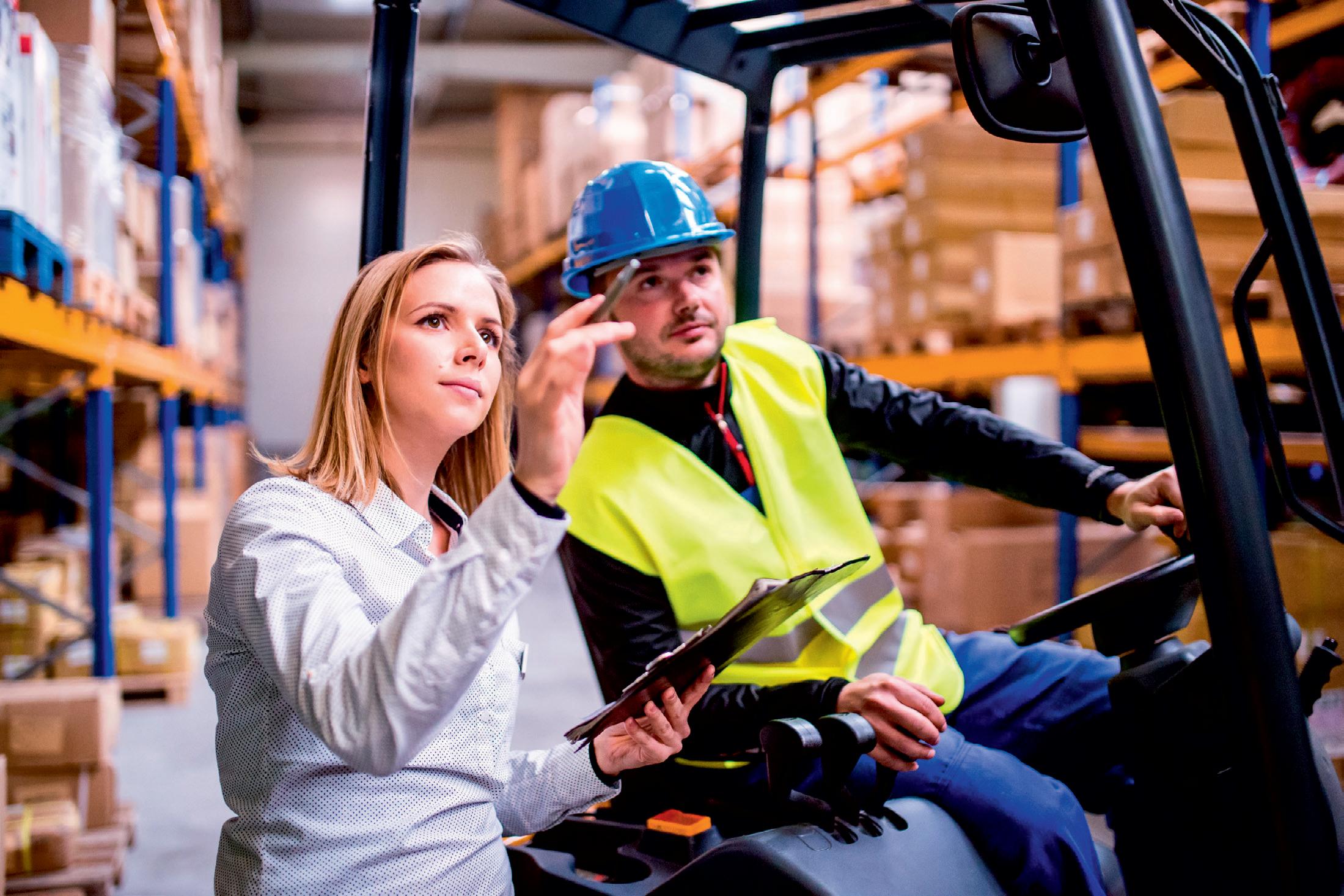



CASE STUDY Fall arrest anchor shows strength through car lift
Fall arrest roof anchors are life saving devices and when conducting work at height it is imperative to know that you can rely on your systems to perform as expected. It can be a matter of life or death. The true test of a fall arrest anchor and the support structure is its ability to provide unfailing strength in a split second. Australian Standards have provided clear parameters to be achieved by manufacturers of fall arrest anchor points. The design, manufacture and installation of all fall arrest anchors comes under various Australian Standards, such as AS/NZS 1891 and AS/NZS 5532.
Anchors must be tested in accordance with their specific standard/s to ensure that they can be classed as meeting minimum performance requirements. The cold hard facts are that anchors installed on roofs that are not capable of meeting minimum standard requirements leave operators at real risk of these systems possibly failing in a fall arrest situation. To claim conformance to AS/NZS 5532, which tests the anchor when installed to the actual roof deck, the Sayfa Group’s 3sixty anchor had to pass the following tests: 1. Dynamic load in-line with roof sheet — 15 kN 2. Static load in-line with the roof sheet — 15 kN 3. Dynamic load across the roof sheet — 15 kN 4. Static load across the roof sheet — 15 kN
But the problem was 15 kN, which is the equivalent of 1530 kg, is that, for many people, it is just a number. Many do not understand how significant this load really is, which was why the car lift demonstration was chosen. “It was important to demonstrate, in a relatable way, the true strength of the 3sixty anchor and the requirements of the new Australian Standard when connected to a roof deck,” Anton Voss, General Manager of Sayfa, said. “We knew

there had to be an experiment that would show it, we just had to come up with one.”
The idea of lifting a car at first seemed impossible; however, the team at Sayfa were determined, according to Technical Manager Murray Voss. “We had several brainstorming sessions and technical meetings to formulate a plan,” Voss said. “From the outset we decided that selecting a car that weighed a similar amount to the testing criteria of 15 kN would prove our point even more effectively.” The support structure was another factor to be considered. Utilising the KOMBI aluminium modular stair and platform system, the team designed and built a strong, but lightweight frame that was able to sustain the weight of the car without buckling or distorting under the pressure. This support base was secured by only using the proprietary KOMBI T-Bolts designed specifically for the KOMBI system.
On the day of the lift, in early 2020, Sayfa team members gathered around in what was supposed to be a normal welcome back meeting. “There was so much excitement amongst the team as they saw a crane start lifting a car and realised they were watching the 3sixty anchor in action,” Voss said. “I think they thought we’d lost our minds.” At the end of the experiment the 3sixty anchor had lifted 1560 kg. “Of course, we were extremely delighted with the demonstration,” Voss said. “We are 100% confident of 3sixty’s strength and design. Still, it was certainly great to see such an outstanding performance.”
Sayfa Group
www.sayfa.com.au
Security and safety signs Security signs can be used to warn of controls and measures put in place to secure a building or area, such as security cameras, alarms, guard dogs or CCTV. New Signs has a range of CCTV Video Surveillance signs that are designed to increase the security of buildings and properties. The security signs are 100% Australian made, with high-quality UV digitally printed graphics. The signs can be delivered Australia-wide, leaving the warehouse in 1–2 business days, with a unique tracking number emailed to customers. New Signs also offers 30-day hassle-free returns.
The company has a wide range of Security and Safety Signs available, with new designs available all the time. New Signs also designs and makes custom safety signs.
New Signs
www.newsigns.com.au


Flex waist mens cargo pant The P/V Gaberdine Flex Waist Mens Cargo Pant from NNT Uniforms provides extra movement and comfort, with belt loops and utility pockets. An update to the CATCFE Cargo Pant, the functionality of cargo pants has been improved by adding a Flexi-Waist feature, with an internal elastic waistband.
The straight leg pant features zip and button closure at the front, with six belt loops and a key loop above the left hip pocket. The cargo pant also has two front hip pockets with an internal pocket flap at the right side, which can be tucked in or pulled out for additional storage. The cargo pant also provides two back patch pockets and two side leg utility pockets with multiple inserts for storage.
NNT Uniforms
www.nnt.com.au Air purifiers and sterilisers The Radic8 Viruskiller air purifier for home and commercial use is designed to trap and destroy 99.99% of viruses, including the cold virus, flu virus, the SARS virus and the Coronavirus DF2. Current air purifiers have HEPA filters, which can trap some but not all pollutants. Air purifiers are suitable for use in medical centres, doctors’ officers and hospitals, which often contain many airborne pathogens from people who are contagious or have compromised immune systems. The Radic8 air purifier neutralises airborne particles, with the Viruskillers for doctors’ offices and medical centres coming in different models, depending on room size.
The Viruskiller is designed to also inactivate the influenza virus by 99.99% when used properly. Radic8 air purifiers and sterilisers are created for a range of commercial and health environments, including medical centres, hospitals, dental offices, hair salons, aged-care facilities, childcare facilities, paramedics/emergency care, schools and universities, hotels, airports, and bus and train stations.
The VK401 Viruskiller is designed for medium to large rooms up to 65 m 2 and is suitable for medical clinics, doctors’ waiting rooms, dental practices and childcare centres. The VK103 Viruskiller with negative pressure option, VK Medi, is suitable for larger spaces up to 165 m2, and features a thick HEPA filter and turbo fan, providing increased air sterilisation. The VK103 is designed for larger medical, hospital, aged-care and education environments.
RADIC8 Australia
radic8.com.au
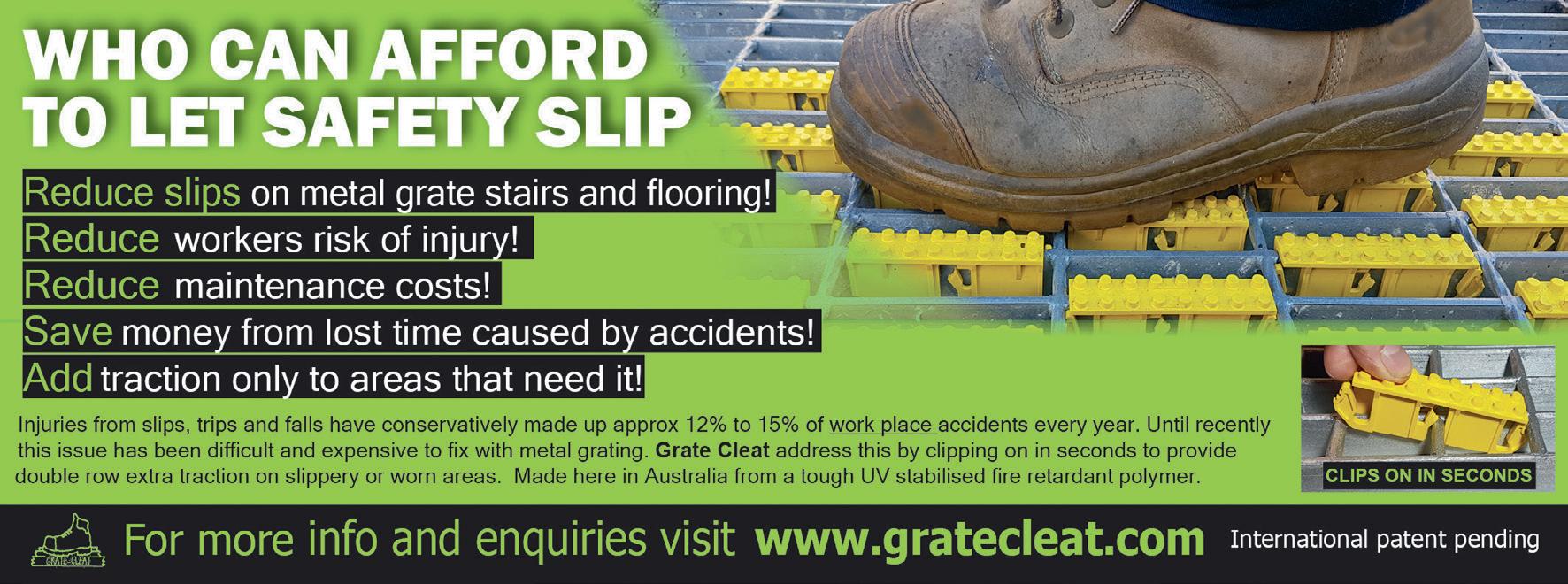
Public access defibrillator GeoSaver is a fully automatic, GeoLocation compatible PAD (public access defibrillator) from Taleb Medical, suitable for any operator with minimal training. It is designed for public access use and licensed to administer fast and safe treatment against cardiac arrest, anytime and before the EMS team arrives.
The product is practical and intuitive, with audible and visual CPR guidance and clear instructions to support the rescuer through the protocol for an effective life-saving action. The GeoSaver is small and lightweight, and equipped with ultra long-life batteries for maximum reliability. The battery is also disposable, and can last up to 400 shocks or six years. The GeoSaver is suitable for adult patients (>8 years old or over 25 kg) and children (1–8 years old or weighing less than 25 kg). The product features several protocols, include escalating energy from 50 to 360 J.
The GeoSaver also provides effective data management, with an SD card capable of recording up to 80 h of ECG, events and voice (operator and environmental). It also comes with an optional IRDA port for data transmission to thermal printer and ‘Saver View Express’ patient managing software. Taleb Medical is an Australian medical equipment supplier, bringing innovative products to the Australian market.
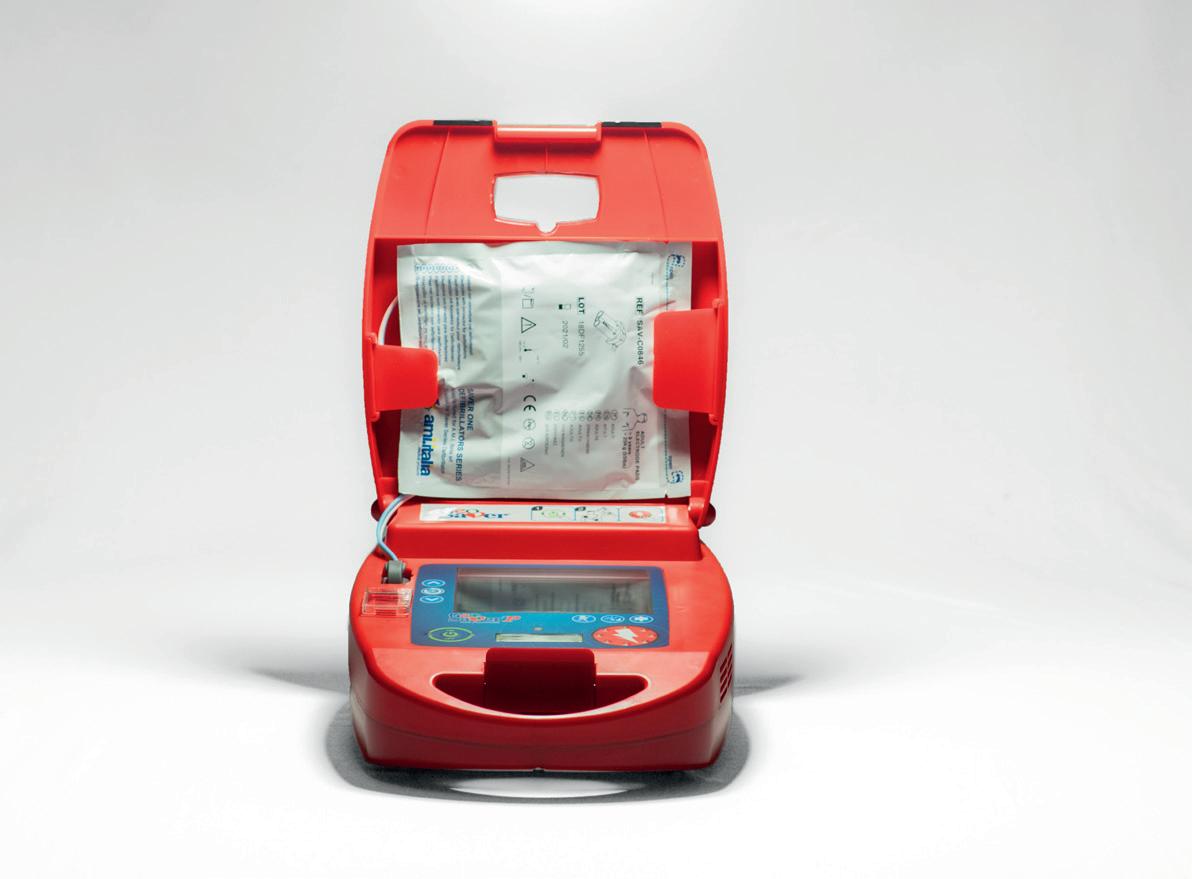
Taleb Medical Pty Ltd www.talebmedical.com
One of these ‘Volunteers’ has an advantage...
Our Rescue Dummies will not;


Complain Tire Break (within reason!) Stop working at temperatures approaching 160°C Get too cold Be late for work Get hungry Require a mask (or social distancing) Mind being buried or thrown out of windows Object to working with HAZMAT Complain about working conditions File for Compo Lose a limb
What they will do is enhance your training and enable you to train in scenarios that are otherwise impossible with live ‘volunteers’. We have 11 categories of Rescue Dummy, and 49 variants. Please contact us to find out which would be best for your training.

With the increased awareness around working at height, the introduction and use of Self Retracting Lifelines (SRLs) as a means of effective anchoring and work positioning has also increased. But with this improved awareness comes an assumption that all fall protection products are equal as far as addressing the multiple risks found in the workplace.
Manufacturers, Product Testing Facilities and Certifi cation/ Standards Organisations around the world have been re-examining how SRLs in fall protection systems perform across a wider variety of applications and orientations, particularly when subjected to sharp edge and leading edge environments. What has been identifi ed is that “leading edge” presents unique hazards to workers at height due to the high potential for lines to become damaged and compromised and the increased potential for swing fall. There is also the risk when workers are attached at foot level they will fall further than they would if anchored at shoulder height or directly overhead increasing issues around fall clearance.
Most SRLs are designed to be mounted to an overhead anchorage point. However, there are certain applications where an overhead anchor is not available, so it is not uncommon to see SRLs used horizontally. But not all SRLs are tested or designed for use in the horizontal plane.
In identifying the “leading edge” risks, manufacturers have redesigned SRLs to work with ground level anchors by engineering extra features to compensate for the changes in the dynamic of the fall and mitigate the increased dangers associated with the change in operational use.
SRLs react to a fall when the lifeline accelerates out of the housing at a certain velocity. When SRLs are anchored at foot level, the lifeline may not achieve the required acceleration during the fall to activate the braking mechanism until after the user’s D-Ring connection passes over the leading edge and they fall below the level of the anchor. This means the user may already have fallen more than 1.6m before the SRL engages and arrests the fall.
Falling further means the impact on the body will be potentially higher when the fall is arrested. This is why leading edge rated products utilise an additional external energy absorber to ensure the forces on the body remain under 6kN.

As mentioned earlier, whilst orienting the SRL on the horizontal and off to one side of the anchor, a fallen worker may swing like a pendulum. Whilst this in and of itself is dangerous, the danger is amplified if the lifeline is extended over a sharp edge and the cable saws back and forth across this edge. If the lifeline bends 90° around the sharp edge of formwork, concrete, or other work surface during a fall, the amount of force generated by the fall arrest can be enough to cut through the lifeline of a standard “overhead” SRL.
Whilst industry has worked to address the risks associated with leading and sharp edge environments, EN and ANSI Standards Organisations have worked to determine certain criteria to define the characteristics of these work areas. Through testing and analysis, they have confirmed a number of factors, including the notion that the use of traditional overhead SRLs anchored at foot-level will see forces generated in excess of the engineered safety parameters of the traditional overhead SRL device.
As a result, Leading Edge SRLs have been developed to comply with these new Standards and address the potential risks associated with leading edge and sharp edge applications. These enhancements include utilising cable and webbing with greater strength and wear resistance properties and specialised energy absorbers and impact indicators to positively identify equipment that has been exposed to a fall.
It is important never to just assume a product is fi t for purpose, and to always check the manufacturer’s instructions or contact them directly to determine if the SRL can be used horizontally.
A key advantage in adopting Lead Edge technology when specifying working at heights PPE is the versatility this type of engineering offers. Managing the correct use of equipment on site can be complicated, especially when work locations do not necessarily allow for access to overhead anchor positions.
Rather than run the risk of workers connecting standard SRLs to incorrect anchor points and introducing new hazards to the existing work area, utilising a Leading Edge SRL allows for horizontal and vertical applications, removes the need for the close monitoring of PPE use and stronger administrative controls and creates an opportunity for a more complete management of working at heights and edge interactions.
MSA’s V-EDGE SRL has been designed to be used in horizontal, overhead, and leading edge applications, taking the guesswork out of equipment selection. We have introduced product features in the design to enhance user experience and the lifespan of the product including the retraction dampening feature which controls the rate of lifeline retraction speed, preventing unwanted damage to the unit, and maximising product longevity.
The ballistic grade polycarbonate casing is engineered to resist impact damage and protect the internal components. In fact, all our componentry is specifi ed with performance, durability and corrosion resistance in mind. The internal componentry is 316 grade Stainless Steel to ensure the device operates safely in the harshest environments.
MSA has also introduced the use of a roll-cage to protect the V-EDGE at foot-level anchors allowing for free movement of the unit during use. This also acts as an ergonomic carry handle.
Our V-EDGE has also been designed for ease of inspection and fi eld serviceability. Operational downtime is minimised through the innovative engineering which requires no calibration. The annual inspection is reduced to a simple visual and tactile one, with the clear polycarbonate case allowing for the internal examination without the need for stripping the unit down.
This unique modular design also means the units are field serviceable. In the event of a fall replacement, parts can be easily installed with minimal training to get the units back into service without having to be sent off site for servicing. This positively infl uences the total cost of ownership considerably, streamlines equipment management processes and ensures workers are never left exposed by essential PPE being unavailable. MSA V-EDGE offers world leading design and performance, ensuring workers at height, regardless of the anchor position, operate safely and are confi dent their PPE will work fi rst time, every time.
A comprehensive range of MSA Fall Protection is available. For further information about the MSA V-EDGE Self Retracting Lifelines please visit: https://au.msasafety.com/leadingedgefallprotection.
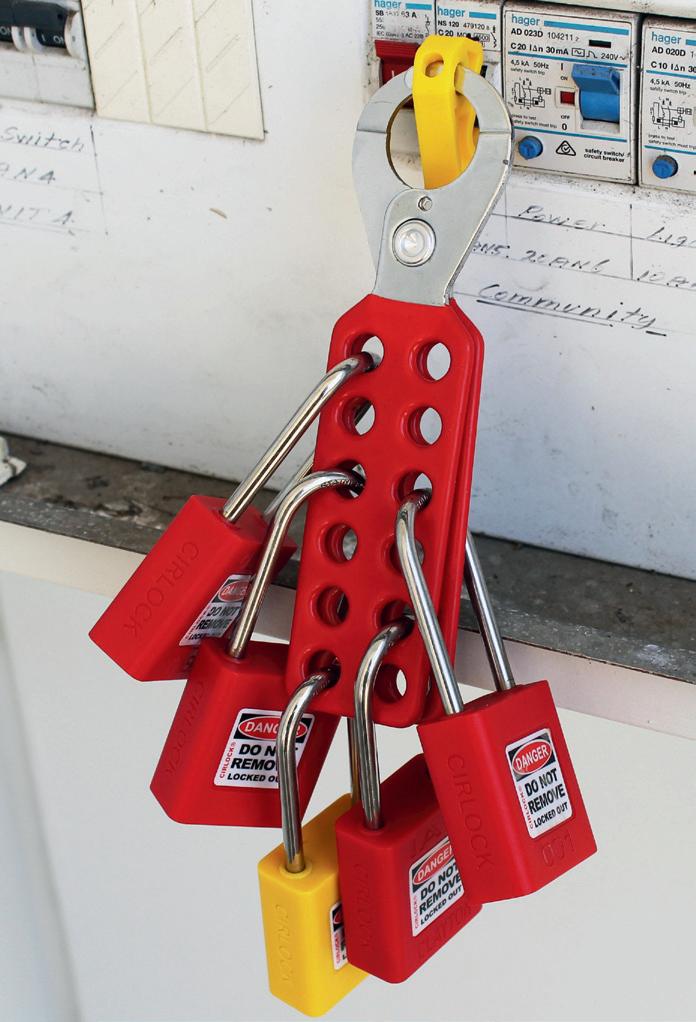
Lockout hasps Lockout hasps are one of the items extensively used in lockout tagout procedures. They are designed to provide maximum protection to workers while they are carrying out maintenance of plant and machinery. The locking facility on a lockout hasp suits group isolation situations — where more than one person is working on a piece of equipment at any one time. The hasp allows multiple personal lockout padlocks to be applied to one isolation point together with a lockout device.
The hasp is attached to the isolation point on the machinery. The person initiating the work then attaches their personal padlock to the hasp. Any other workers who may need to simultaneously do maintenance on the machinery also attach their personal lockout padlocks to the hasp, preventing the machinery from being operated until all locks have been removed.
To support your procedures, Cirlock has a full range of lockout hasps, available in many different sizes, from 6 holes to 24 holes. Hasps are also available in aluminium and non-conductive materials, as well as high visibility hasps.
Cirlock
www.cirlock.com.au
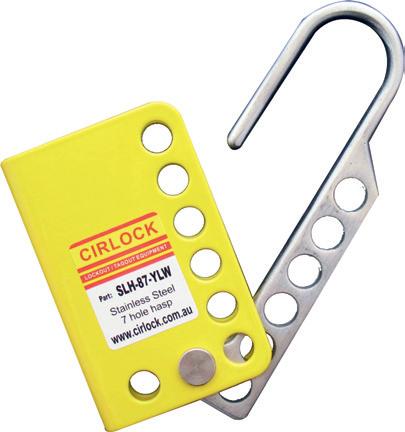
In-line air regulator Factory set to prevent pressure changes, the ToolReg In-line Air Regulator is designed to be fully tamper-proof and ensure that only the required pressure is used for each individual pneumatic tool. The automatic secondary pressure relief releases all the residual pressure in the pneumatic tool to prevent unexpected activation (common in nail guns and staplers).
Compressed air is expensive to generate as there is a lot of energy (electrical and mechanical) involved in producing it. Higher compressed air pressures require far more energy to produce. On average, the air compressor requires 1% more energy for every 0.15 bar increase in compressed air pressure.
Each pneumatic tool is designed to perform best at a given pressure. Operating the tool at a higher pressure not only reduces the performance but also shortens the possible lifecycle of the tool.
The ToolReg is an economical investment for energy efficiency. It optimises performance and lengthens the lifespan of the tool, as well as preventing loss of production time due to the damaged tool being out for repairs.
Compressed Air Australia Pty Ltd
www.caasafety.com.au Personal protective clothing Bruck XCELL 260 fabric provides those at risk from exposure to heat and flame with a lightweight, high-strength natural fibre, featuring next-to-skin comfort and breathability. The fabric was developed to provide firefighters and workers exposed to electric arc, flammable gas or liquid or flash fire with a single layer of fabric that is sustainable and provides comparable mechanical performance to synthetic materials. Bruck has achieved this using Australian cotton and the durable PROBAN flame-resistant process.
Garments made from XCELL 260 fabric are available in highdaytime-visibility warning colours, and are suitable for certification to ISO 11612, AS/NZS 4824 and ISO 15384. The garments also fulfil the requirements of NFPA 70E PPE Category 2. Further benefits from cotton add resistance to UV degradation and high tear resistance even when wet. The result is a performance fabric for those seeking to purchase garments with a long service life and improved sustainability outcomes.
BRUCK TEXTILES
www.brucktextiles.com.au

Speed gates Smart technology company RCT’s Muirhead Speed Gates are designed to ensure all industrial vehicles — such as forklifts and reach trucks — are travelling at an appropriate speed for their surroundings.
The systems are easily deployed at entrances/exits and designated points within warehouses and other materials handling facilities and cap maximum speeds on any piece of industrial equipment passing through the portal.
A worksite may be set up to cover up to four safe speeds per site so the materials handling equipment can only travel at designated speeds through specific areas such as yards, racking aisles, calm zones (pedestrian areas) or under awnings.
The Speed Gate system consists of a gate that is to be located above entrances/exits which communicates with a machine location tag mounted on or close to the roof or falling object protective structure (FOPS) of a forklift.
The machine location tag then communicates with a Muirhead Speed Limiter to manage the speed of the forklift depending on the specific location it is traversing through onsite. Additionally, depending on machine type, Speed Gates may be able to interface directly with OEM speed limiting features.
Simple to install, the system requires no ongoing maintenance and can be applied to any type of materials handling equipment regardless of manufacturer. It is suitable for large and small sites that operate mixed fleets.


RCT
www.rct-global.com
Can you afford not to test?
Eliminate Drug & Alcohol abuse at your workplace with Pathtech

The Securetec DrugWipe
› Number 1 selling saliva testing device in Australia › Used by every Australian Police Jurisdiction for roadside drug screening › Accurate, reliable and results in 8 mins
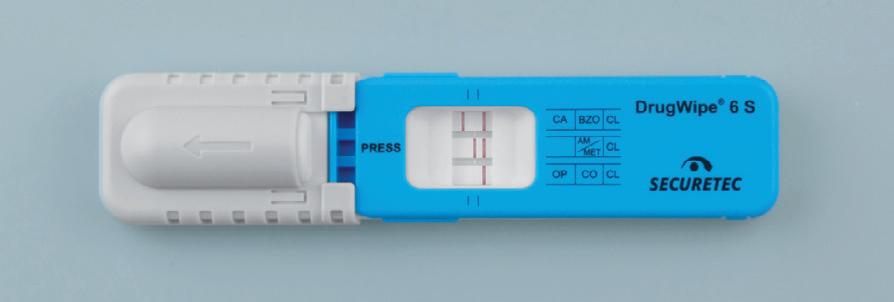
Up to 15%
of workplace injuries worldwide are attributable to drug & alcohol use
Around 60%
of individuals who consume drugs & alcohol at harmful levels are in full time employment
Estimated $6 billion
per year in lost productivity through alcohol & other drugs in Australian workplaces
Pathtech, First Choice in Drug Detection
Contact us today to discuss your Drug & Alcohol detection needs
Phone 1800 069 161 | Email drugwipe@pathtech.com.au





